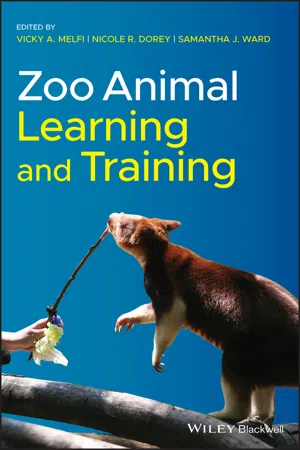
Zoo Animal Learning and Training
- English
- ePUB (mobile friendly)
- Available on iOS & Android
Zoo Animal Learning and Training
About This Book
Comprehensively explains animal learning theories and current best practices in animal training within zoos
This accessible, up-to-date book on animal training in a zoo/aquaria context provides a unified approach to zoo animal learning, bringing together the art and science of animal training. Written by experts in academia and working zoos, it incorporates the latest information from the scientific community along with current best practice, demystifying the complexities of training zoo animals. In doing so, it teaches readers how to effectively train animals and to fully understand the consequences of their actions.
Zoo Animal Learning and Training starts with an overview of animal learning theory. It describes the main categories of animal learning styles; considers the diverse natural history of zoo animals; reviews the research undertaken which demonstrates ultimate benefits of learning; and highlights the advantages and disadvantages of the different approaches. It also shows how the direct application of learning theory can be integrated into zoo animal management; discusses how other factors might affect development; and investigates situations and activities from which animals learn. It also explores the theoretical basis that determines whether enrichments are successful.
- Provides an easily accessibly, jargon-free introduction to the subject
- Explores different training styles, providing theoretical background to animal learning theory as well as considerations for practical training programme – including how to set them up, manage people and animals within them and their consequences
- Includes effective skills and 'rules of thumb' from professional animal trainers
- Offers commentary on the ethical and welfare implications of training in zoos
- Features contributions from global experts in academia and the zoo profession
- Uniquely features both academic and professional perspectives
Zoo Animal Learning and Training is an important book for students, academics and professionals. Suited to senior undergraduate students in zoo biology, veterinary science, and psychology, and for post-graduate students in animal management, behaviour and conservation, as well as zoo biology. It is also beneficial to those working professionally in zoos and aquaria at different levels.
Frequently asked questions
Information
Part B
Types of Learning That Can Be Achieved in a Zoo Environment
5
What Is There to Learn in a Zoo Setting?
5.1 Introduction
5.2 Early Life
5.2.1 Embryonic Learning
5.2.2 Recognising Parents and Mates
Table of contents
- Cover
- Table of Contents
- Notes on Contributors
- Foreword
- Preface
- Acknowledgements
- Part A: Demystifying Zoo Animal Training
- Part B: Types of Learning That Can Be Achieved in a Zoo Environment
- Part C: More Than A to B
- Glossary
- Index
- End User License Agreement